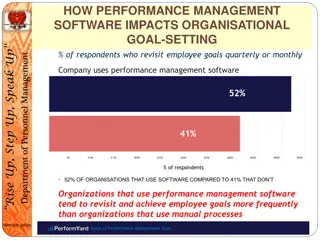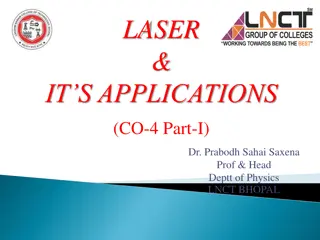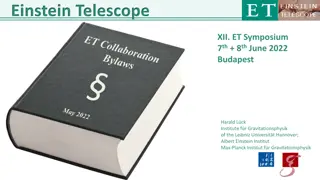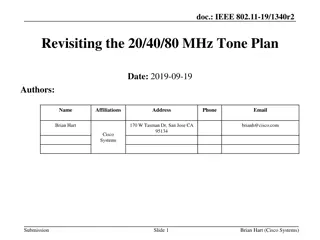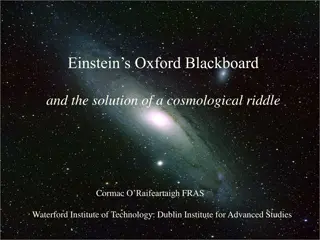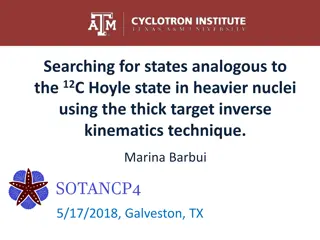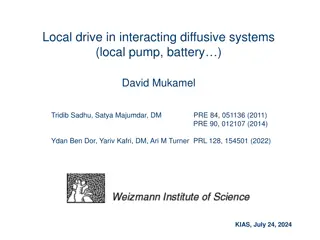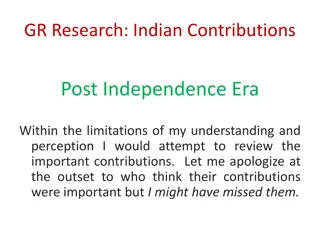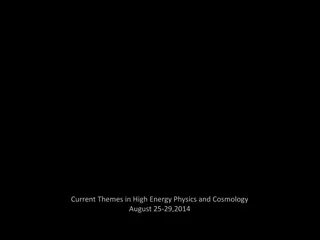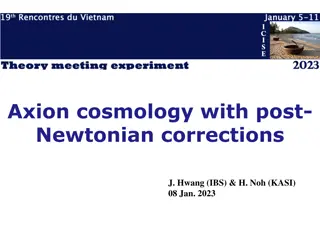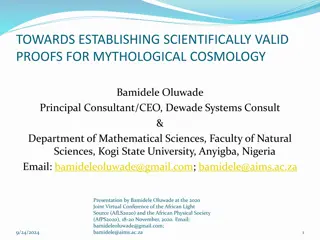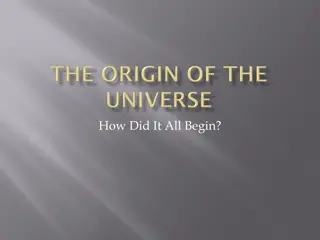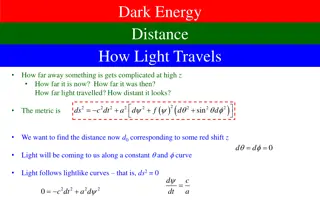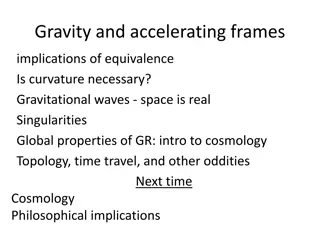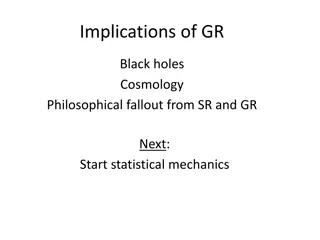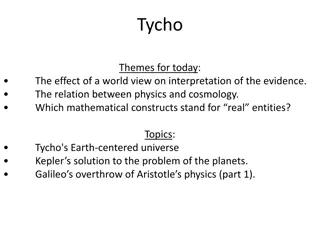Revisiting Steady-State Cosmology: From Einstein to Hoyle
Explore the historical evolution of cosmological models from Einstein's steady-state theory to the Big Bang hypothesis, examining key figures, discoveries such as Hubble's law, and debates about the universe's expansion. The article delves into Einstein's contributions, the challenges of integrating general relativity with cosmic observations, and the transition to evolving cosmological models proposed by Friedman. Join the cosmic journey through new perspectives on the cosmos.
Download Presentation

Please find below an Image/Link to download the presentation.
The content on the website is provided AS IS for your information and personal use only. It may not be sold, licensed, or shared on other websites without obtaining consent from the author.If you encounter any issues during the download, it is possible that the publisher has removed the file from their server.
You are allowed to download the files provided on this website for personal or commercial use, subject to the condition that they are used lawfully. All files are the property of their respective owners.
The content on the website is provided AS IS for your information and personal use only. It may not be sold, licensed, or shared on other websites without obtaining consent from the author.
E N D
Presentation Transcript
New perspectives on steady-state cosmology From Einstein to Hoyle The Big Bang: Fact or Fiction? Cormac O Raifeartaigh (Waterford Inst of Technology) Simon Mitton (University of Cambridge)
Einsteins steady-state model Unpublished AE manuscript Written in early 1931 Contains steady-state model of the cosmos Expanding universe of constant matter density Continuous formation of matter from vacuum Anticipates controversial theory (Hoyle) Einstein in California (1931) Inconsistent model Fatal flaw Abandoned, not amended Evolving models embraced Friedman-Einstein, Einstein-de Sitter
Hubbles law (1929) Spiral nebulae extra-galactic (1925) 100-inch reflector at Mt Wilson Resolved Cepheid stars in several nebulae Leavitt s period-luminosity relation A distance/redshift relation for the spirals? Redshifts of the nebulae by VM Slipher (1915,1917) Approx linear relation (Hubble, 1929) Some anomalies (Peacock) Slipher not acknowledged H = 585 kms-1Mpc-1
A cosmic puzzle What is causing recession of the galaxies ? If redshifts are velocities If effect is non-local Newton s law of gravity Gravity pulls in, not out No other long range force for neutral matter Space, time are fixed Not affected by contents of universe Eternal, infinite universe
General relativity (1915) Space+ time = space-time Space-time dynamic Distorted by motion, mass Gravity = curvature of space-time G = T Albert Einstein Empirical evidence Perihelion of Mercury Bending of starlight (Eddington, 1919)
Einsteins universe (1917) Apply general relativity to the cosmos Equations predict dynamic universe Expanding or contracting No evidence for such a universe Unaware of Slipher redshifts Add cosmic constant to give static solution G + g = T
Friedman models of the cosmos Allow time-varying solutions to the field equations Expanding, contracting universes Alexander Friedman 1888 -1925 Geometry, evolution depends on matter content Positive curvature (1922) Hyperbolic curvature (1924) Evolving models (Zf. Ph.) Matter density varies over time Ignored by community Disliked by Einstein Correction and retraction
Lematres universe (1927) Redshifts of galaxies = expansion of space? Rate of expansion from mean distances and redshifts H = 585 km/s/Mpc (1927) Fr Georges Lema tre No beginning: indefinite age Starts from Einstein universe at t = - Not an empirical law Rejected by Einstein Votre physique est abominable Ditto for Friedman models
An expanding universe? (1930-) RAS meeting (1930) Eddington, de Sitter If redshifts are velocities, and effect is non-local Hubble s law = expansion of space? Static relativistic models don t fit data Dynamic models required Friedman-Lema tre models Time-varying radius Variable matter density Evolving universe Cosmic expansion?
The expanding, evolving universe (1930 -) Eddington (1930, 31) On the instability of the Einstein universe Expansion caused by condensation? de Sitter (1930, 31) Further remarks on the expanding universe Expanding universes of every flavour Tolman (1930, 31) On the behaviour of non-static models Expansion caused by annihilation of matter ? Einstein (1931, 32) Friedman-Einstein model = 0, k = 1 Einstein-de Sitter model = 0, k =0 If redshifts represent expansion Evolving models
New: Einsteins steady-state model (1931?) Filed as draft of F-E model Similar title, opening Cites Hubble s law Cites instability of static model Cites evolving models Discusses age problem Proposes alternative solution Expanding, unchanging cosmos? Continuous creation of matter Associates with - energy of space
Einsteins steady-state model: key quotes New solution In what follows, I wish to draw attention to a solution to equation (1) that can account for Hubbel sfacts, and in which the density is constant over time Matter creation If one considers a physically bounded volume, particles of matter will be continually leaving it. For the density to remain constant, new particles of matter must be continually formed within that volume from space Dark energy The conservation law is preserved in that, by setting the -term, space itself is not empty of energy; its validity is well known to be guaranteed by equations (1).
An abandoned model A fatal flaw De Sitter metric Matter creation associated with Null result masked by error Derivation incorrect Einstein s crossroads Identifed problem on revision Declined to amend GFE Evolving models? Less contrived and set = 0
The steady-state universe (1948) Expanding but unchanging universe Hoyle, Bondi and Gold (1948) No beginning, no age paradox No assumptions about physics of early epochs Continuous creation of matter Very little matter required Bondi, Gold and Hoyle Replace with creation term (Hoyle) Conservation of energy violated G + C = kT Improved version (1962) Hoyle and Narlikar (1962) G + g = kT (C + C )
Evolving vs steady-state universe Radio-astronomy Galaxy distributions at different epochs Cambridge 3C Survey (Ryle) Cosmic microwave background Low temperature, low frequency Remnant of early universe Optical astronomy Amended timescale of expansion (Baade, Sandage)
Significance of Einsteins steady-state model Unsuccessful theories important Understanding the development of successful theories New perspective on steady-state theory Logical possibility: not a crank theory Insight into Einstein s philosophy Discards model rather than add new term to GFE Occam s razor approach Insight into scientific progress Not Kuhnian paradigm shift Slow dawning Links with modern cosmology Dark energy: creation energy and Cosmic inflation: de Sitter metric
Einsteins steady-state model and cosmology today Dark energy (1998) Accelerated expansion (observation) Positive cosmological constant Einstein s dark energy The conservation law is preserved in that, by setting the -term, space itself is not empty of energy; its validity is well known to be guaranteed by equations (1). Cosmic inflation Inflationary models use de Sitter metric Used in all steady-state models Flat curvature, constant rate of matter creation Different time-frame!
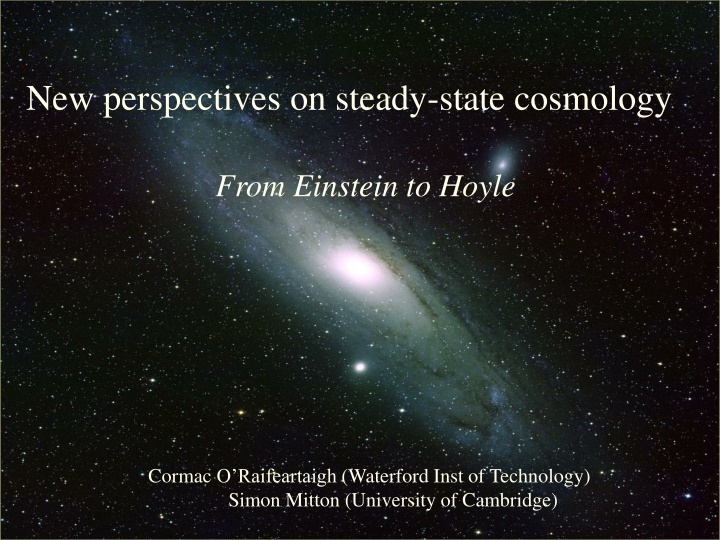

![[PDF⚡READ❤ONLINE] Cosmology and Particle Astrophysics (Wiley-Praxis Series in As](/thumb/21627/pdf-read-online-cosmology-and-particle-astrophysics-wiley-praxis-series-in-as.jpg)
